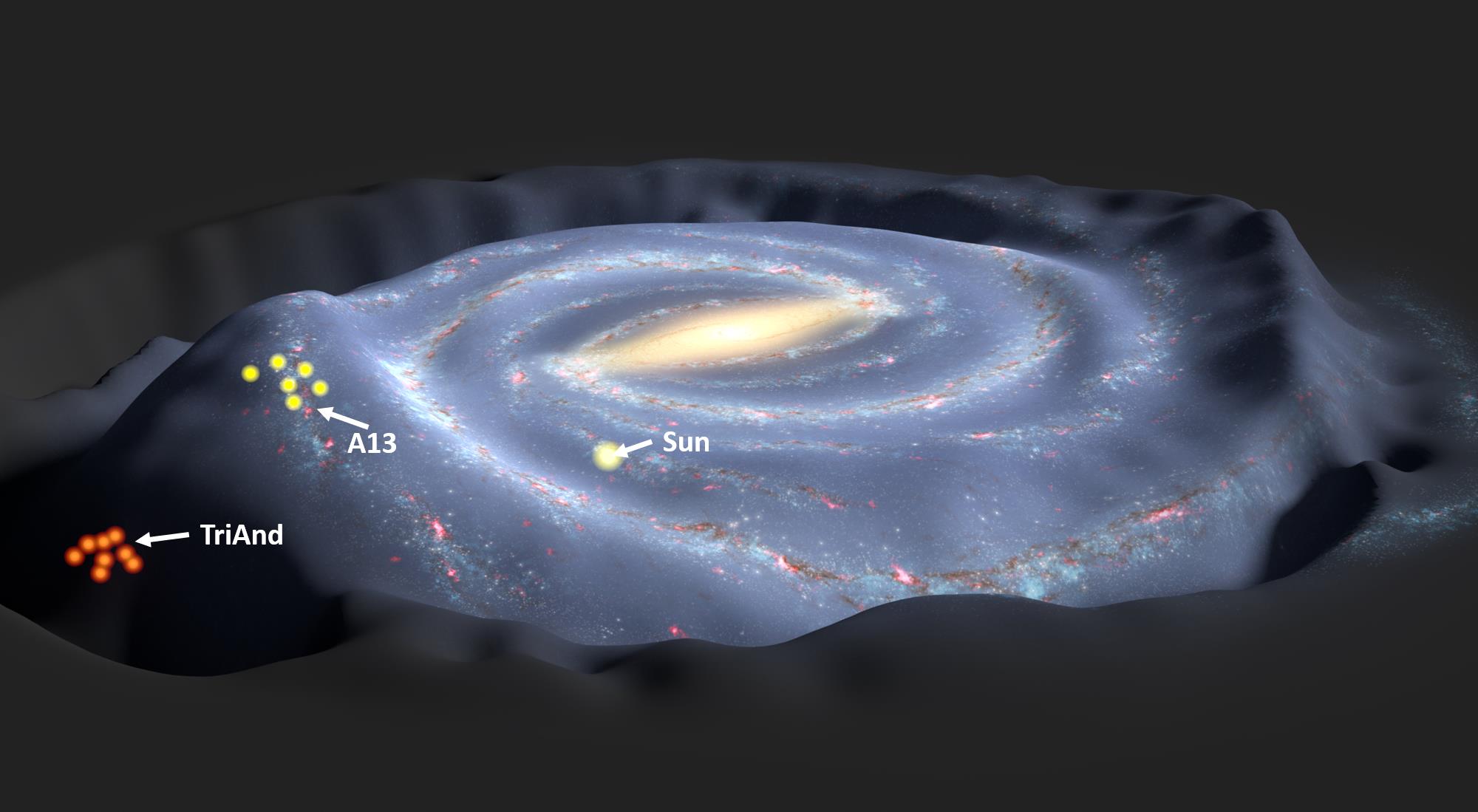Stars in the Milky Way halo: Cosmic invaders or victims of galactic eviction? [NOT TRANSLATED]

The stars investigated belong to two different structures located in the Galactic halo, the Triangulum-Andromeda (TriAnd) and A13 overdensities. These two structures are located on opposite sides of the Milky Way, about 14.000 light years below and above the Galactic plane (see Figure 1), and were initially thought to be the debris left behind by smaller galaxies that invaded the Milky Way in the past.
But in the study published today in Nature, astronomers present compelling evidence showing that these structures actually originate from the Milky Way’s disc itself, but were kicked out towards the halo.
foto
Figure 1: The Milky Way galaxy, perturbed by the tidal interaction with a dwarf galaxy, as predicted by N-body simulations. The locations of the observed stars above and below the disc, which are used to test the perturbation scenario, are indicated. Credit: T.Mueller/NASA/JPL-Caltech
The key to understanding the origin of these stars lies in their detailed abundance patterns, obtained using the high-resolution spectra taken with the Keck and the VLT (Very Large Telescope, ESO) telescopes. “The analysis of chemical abundances is a very powerful test which allows, similarly to the DNA matching, to identify the parent population of the star. Different parent populations, such as the Milky Way disc or halo, dwarf satellite galaxies or globular clusters, are known to have radically different chemical compositions. So once we know what the stars are made of, we can immediately link them to their parent populations.”, explains M. Bergemann, the leading author of the study.
The comparison of the chemical composition of these stars shows that they are almost identical, both within and between groups. Even more surprisingly, their composition closely matches the typical abundance pattern of Milky Way disk stars. This provides compelling evidence that these stars likely originate from the Galactic thin disk itself, rather than being debris from the disruption of one or many of the smaller galaxies that are thought to have been accreted by our Galaxy in the past.
But how did the stars then get to these extreme positions above and below the Galactic disk? Models of the evolution of the Milky Way predict this “Galactic eviction” to happen as the result of oscillations of the Galactic disk as a whole. The favoured explanation for these oscillations is the tidal interaction of the Milky Way with a massive satellite galaxy.
The results published in Nature now provide the clearest evidence for these oscillations of the Milky Way’s disk so far. These results indicate that the dynamics of the Milky Way’s disk is significantly more complex than previously thought and disk stars can be relocated to distant locations from their birthplace.
“Future work includes the improved determination of the distances and motions of the stars in these overdensities, especially critical will be the data from the Gaia space mission. This will test our interpretation that the overdensities are the crests of the large-scale Galactic wave. Moreover, future determination of ages of the stars with asteroseismology will allow to date when the interaction of the Milky Way and the satellite galaxy happened.” said M. Bergemann and A. Serenelli.
Background information
The results described here were published in Bergemann et al., “Two chemically similar stellar overdensities on opposite sides of the Galactic disc plane” in the journal Nature (http://dx.doi.org/ using the identifier 10.1038/nature25490).
Information about advanced access to the Nature article can be obtained at press@nature.com
Aldo Serenelli, from the Institute of Space Sciences (ICE, CSIC) and Institute of Space Studies of Catalonia (IEEC) in collaboration with Maria Bergemann (Max Planck Institute for Astronomy, MPIA) , Branimir Sesar (MPIA), Judith G. Cohen (California Institute of Technology), Allyson Sheffield (City University of New York), Ting S. Li (Fermi National Accelerator Laboratory), Luca Casagrande (The Australian National University), Kathryn Johnston and Chervin F.P. Laporte (both Columbia University, New York), Adrian M. Price-Whelan (Princeton University) and Ralph Schönrich (University of Oxford, UK), Andrew Gould (MPIA) [NOT TRANSLATED]
